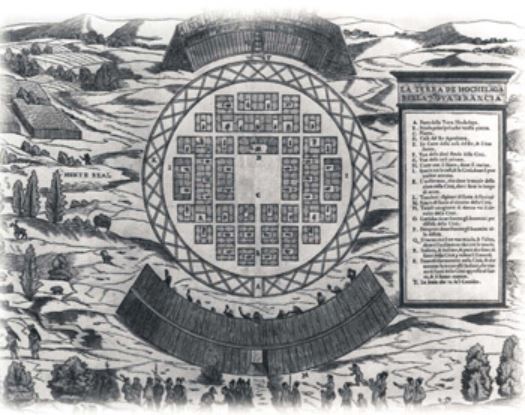Warfare In Pre-Columbian North America
The European explorers who ‘discovered’ the Americas in the 15th Century came to a land already inhabited by a diverse and substantial indigenous population. According to Aboriginal creation stories, their ancestors had lived here forever. According to archaeologists, human beings had been living in what is now Canada for at least 12,000 years and probably much longer.
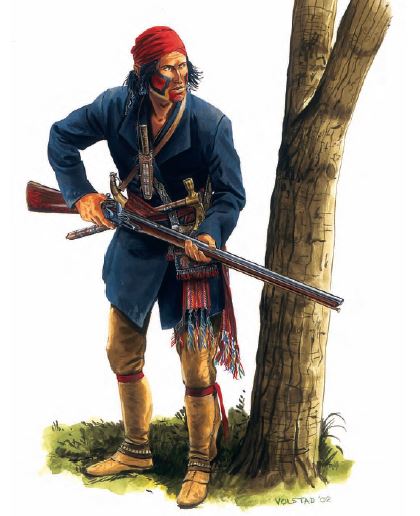
Mohawk Warrior from Tyendinaga, Autumn 1813
The warriors from the small Mohawk community at Tyendinaga near Kingston, although few in numbers, participated in much fighting during the War of 1812, seeing action at Sacketts Harbor and in the Niagara peninsula in 1813. Their most prominent service was rendered at the battle for Crysler’s Farm in November, 1813 where they played a role disproportional of their numbers. This warrior is depicted as he may have appeared at Crysler’s Farm. Painting by Ron Volstad (Department of National Defence).
The indigenous peoples in this land were divided into a number of nations, which ethnologists classify on the basis of cultural and linguistic characteristics. In the east, from the Atlantic coast to the Great Lakes area, Algonquian and Iroquoian peoples mingled and divided the available resources in the sub-Arctic boreal forest and north-eastern deciduous woodlands. The former were generally nomadic, living by hunting, gathering and fishing. Generally, the Beothuk in Newfoundland, the Mi’kmaq, Abenaki and Malecite in the Maritimes, and the Algonquin, Attikamekw, Naskapi, Montagnais (now known as Innu), Odahwah, Nipissing, Ojibway and Cree in Quebec and Ontario all gathered in summer at sites of major fisheries to socialize, trade and make alliances. In the fall, they would disperse into kin-based hunting bands for the winter. On the other hand, the nations that spoke Iroquoian languages were much more sedentary. The Five Nations (also known as the Iroquois or Hodenosaunee), as well as the Huron, the Neutral, the Petun and the Erie, lived in villages of as many as 2,000 people in the area around Lake Ontario, Lake Erie and Lake Huron. Their homes were 10-30 metre-long ‘longhouses’ made of wood and covered with bark that each housed three to five families. They enjoyed a milder climate than most of their Algonquian neighbours that permitted the most northerly extension of indigenous agriculture in North America, growing corn, squash, beans, sunflowers and tobacco.
In the northern Plains, the Assiniboine and Blackfoot lived a nomadic pedestrian existence. They survived mainly by hunting bison, which were abundant at the time and met nearly all their needs, providing not only food but also hides for clothing and lodge coverings, as well as horn and bones for tools and weapons. In the sub-arctic forests that stretched from northern Manitoba through the Northwest Territories to the Yukon lived highly mobile Athapascan speaking nations, including the Chipewyan, Slavey, Sekani, Dogrib, Beaver, Sarcee and Hare among others. They had a lifestyle similar to that of the Algonquian nations and subsisted mainly by hunting moose and caribou. On the other side of the Rockies were the peoples of the cordillera and Pacific Coast. Those nations in the mountainous interior included the Kootenay, as well as various Interior Salish and Athapascan speakers, who lived a varied hunting and gathering existence. In the linguistically diverse coastal region, Haida, Kwakwaka’wakw, Nuu chah nulth, Cowichan, Tlingit, Tsimshian, and others lived a lifestyle built around salmon and cedar. The rich subsistence economy of the region enabled some of the densest and most complex hierarchical societies found amongst hunter-gatherers anywhere in the world. The semi-sedentary patterns combined with the wealth of the coastal rain forest to enable highly elaborate artistic traditions to develop in wood carving, which they used to build homes and make canoes, utensils and various ceremonial and religious objects. The nations of this region were the last to come into contact with Europeans, when Russian, Spanish and British explorers arrived in the mid-to-late 18th Century.
Finally, the Thule and their cultural and biological descendants, the Inuit, whom the French generally called ‘Esquimaux,’ lived in the arctic north of the tree line. Their ingenious technologies, from snowhouses to kayaks, allowed them to live in an unaccomodating environment, where they necessarily relied on animal resources to survive. For most groups, the sea provided the most important resources: for example, seals provided food for humans and dogs, oil to heat homes and cook food, and hides which could be made into boots, summer clothing, tents, harpoon lines and dog harnesses. On land, caribou was their most important prey, providing meat, hides and sinew for clothing, and antler for tools. The Inuit seasonal cycle, like those followed by other indigenous peoples in northern North America, was well adapted to the characteristics of their homeland.
Warfare in Aboriginal societies
Despite the myth that Aboriginals lived in happy harmony before the arrival of Europeans, war was central to the way of life of many First Nation cultures. Indeed, war was a persistent reality in all regions though, as Tom Holm has argued, it waxed in intensity, frequency and decisiveness. The causes were complex and often interrelated, springing from both individual and collective motivations and needs. At a personal level, young males often had strong incentives to participate in military operations, as brave exploits were a source of great prestige in most Aboriginal cultures. According to one Jesuit account from the 18th Century, ‘The only way to attract respect and public veneration among the Illinois is, as among the other Savages, to acquire a reputation as a skilful hunter, and particularly as a good warrior … it is what they call being a true man.’ Among west coast societies, the material goods and slaves acquired through raiding were important avenues to build up sufficient wealth to host potlatches and other give-away ceremonies. At a community level, warfare played a multifaceted role, and was waged for different reasons. Some conflicts were waged for economic and political goals, such as gaining access to resources or territory, exacting tribute from another nation or controlling trade routes. Revenge was a consistent motivating factor across North America, a factor that could lead to recurrent cycles of violence, often low intensity, which could last generations. Among the Iroquoian nations in the northeast, ‘mourning wars’ were practiced. Such conflicts involved raiding with the intent to capture prisoners, who were then adopted by bereaved families to replace family members who had died prematurely due to illness or war.
Archaeological evidence confirms the prominent role of warfare in indigenous societies well before the arrival of permanent European settlers. As early as the year 1000, for example, Huron, Neutral, Petun and Iroquois villages were increasingly fortified by a timber palisade that could be nearly 10 metres in height, sometimes villages built a second or even third ring to protect them against attacks by enemy nations. Craig Keener has described how these structures became larger and more elaborate through to the 1500s, with logs as large as 24 inches in diameter being used to construct the multi-layered defences, an enormous investment in communal labour that the villagers would not have made had it not been deemed necessary. Sieges and assaults on such fortified villages therefore must have occurred before Europeans arrived, and were certainly evident in the 17th and 18th Centuries. War also fuelled the development of highly complex political systems among these Iroquoian nations. The great confederacies, such as the Iroquois Confederation of Five Nations and the Huron Confederacy, probably created in the late 16th Century, grew out of their members’ desire to stem the fratricidal wars that had been ravaging their societies for hundreds of years. They were organized around the Confederacy Council, which ruled on inter-tribal disputes in order to settle differences without bloodshed. The Councils also discussed matters of foreign policy, such as the organization of military expeditions and the creation of alliances.
Traditional military practices
Warfare prior to European colonisation varied by region, and much of the discussion below focuses on the northeast woodlands, but some patterns were commonly in evidence. In areas where large war parties could come together, formal battles occurred that were often highly ritualised and conducted in ways that limited the casualties. For instance, fur trader David Thompson recorded the following description by the Peigen elder, Saukamappee, of a battle with the Shoshone in the Eagle Hills region of Saskatchewan when he was a youth, long before the arrival of European guns and horses.
After some singing and dancing, they sat down on the ground, and placed their large shields before them, which covered them. We did the same, but our shields were not so many, and some of our shields had to shelter two men. Theirs were all placed touching each other; their bows were not so long as ours, but of better wood, and the back was covered with the sinews of the bisons which made them very elastic, and their arrows went a long way and whizzed about us as balls do from guns … on both sides, several were wounded, but none lay on the ground; and the night put an end to the battle without a scalp being taken on either side, and in those days such was the result unless one side was more numerous than the other.
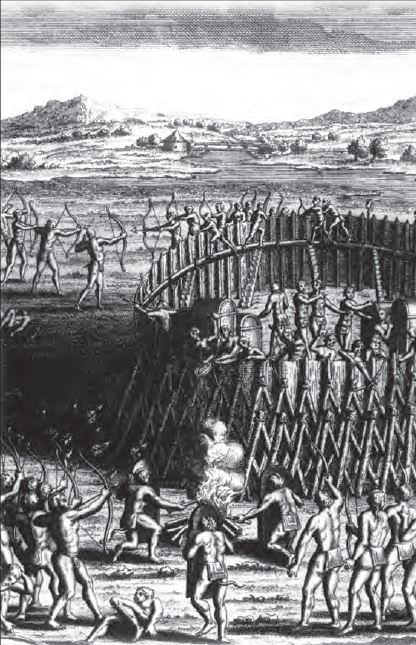
Attack on aboriginal fort
Attack on a fort during a battle between two Aboriginal nations. (Library and Archives Canada (C-92245))
Similarly, in 1609, the French explorer Samuel de Champlain fought a battle against the Iroquois, alongside his Montagnais allies. According to his detailed account of the encounter, the military practices were highly ritualistic and governed by strict rules. For example, when the two groups met on the shores of Lake Champlain, they negotiated the time at which the battle would take place. They decided to ‘wait until day to recognize each other and as soon as the sun rose’ they would wage battle. ‘The entire night was spent in dancing and singing,’ reports Champlain, with the two camps shouting ‘an infinite number of insults’ and threats at each other. When the sun rose, the armies, each made up of more than 200 warriors, faced each other in close ranks and approached calmly and slowly, preparing to join combat. All the warriors were armed with bows and arrows, and wore armour made of wood and bark woven with cotton. When Champlain and two other French soldiers opened fire with their arquebuses, they killed the three main Iroquois chiefs and the enemy retreated. Finally, hand-to-hand combat was engaged and the allies of the French captured 10 or 12 prisoners.
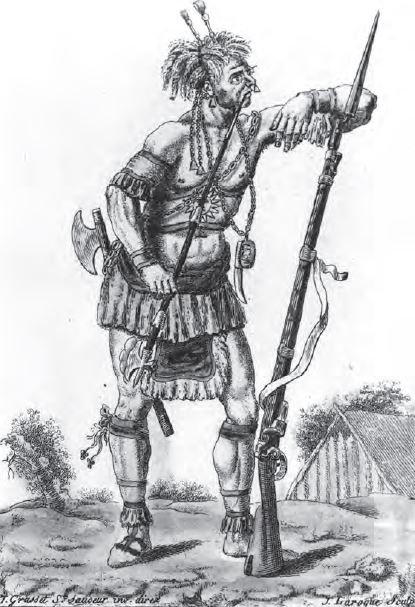
Iroquois Warrior with musket, c.1730
This man wears aboriginal clothing but is armed with a French military musket, acquired either through combat or trade, a war axe with an iron blade and a small scalping knife hung around his neck. Note the bayonet on the musket – although aboriginal warriors adopted European weapons, they did not adopt European tactics and were more likely to engage in hit and run ambushes than in stand-up, closequarter fighting. (Library and Archives Canada (C-003163))
Most Europeans were derisive of such relatively bloodless sport. It was “more of a pastime than to conquer or subdue enemies,” Captain John Underhill of Massachusetts Bay concluded after observing one such engagement. However, Europeans were less likely to witness the more common and more deadly raiding and ambushes that characterised the indigenous way of war across the continent. In the northeast woodlands and elsewhere, the advent of European firearms would quickly render such open field combat too costly according to indigenous cultural norms of war. After 1609, most observers reported that Aboriginal people did ‘not know how to fight in open country,’ and accounts of Aboriginal warfare usually described hit and run military techniques, which the French called ‘la petite guerre.’ This was essentially a form of guerrilla warfare, the primary goal of which was to inflict casualties, capture prisoners and take scalps, while suffering as few losses as possible. To do so, the warriors generally moved in small groups and took pains to catch the enemy unawares or encircle it, while eluding the same tactics by the other side. They took advantage of the terrain to remain concealed and ambush the enemy, or slipped into a camp by night to surprise the occupants in their sleep. Once they had achieved their objective, the warriors retreated before a counter-attack could be mounted.
While it suited conditions in the forests of North America, Aboriginal guerrilla warfare was far removed from European methods of the time. To Europeans, who believed that rigid discipline was essential to produce a soldier capable of producing maximum fire through massed formation in the open, the Aboriginal warriors generally seemed to be undisciplined fighters without any sense of tactics. Moreover, “skulking” behind trees was viewed as cowardly, and actually aiming, particularly at officers, was unsporting and barbaric. Writing in 1715, the renowned French officer Louis Laporte de Louvigny described Aboriginal warriors as:
without order or discipline, with customs opposed to our own, who make promises they do not keep, follow as long as they wish, and return to their villages, readily abandoning the best planned enterprise on account of a mere dream, some superstition or some small unexpected accident …. Their fighting was limited to killing some man, taking the spoils, and when they are fortunate enough to destroy a French canoe or to find war munitions and clothes to wear, these are immense riches for them.
However, Aboriginal warriors had a high regard for their own tactics, and were themselves often dismissive of Europeans modes of combat, which they considered courageous folly. For example, Makataimeshekiakiak (Black Sparrowhawk), a Sauk war chief who fought in the War of 1812, wrote:
Native-Newcomer contact brought two distinct military systems into interaction in North America, and initiated a process of mutual learning and borrowing.
Warriors and raids
While women played an important social and political role in indigenous societies, military activities were, like hunting, usually reserved for men. From a young age, boys were initiated into the use of weapons and were taught how to kill both animals and humans. The interrelationships between war and hunting were so close that warriors going to battle would sometimes say they were going ‘hunting for men.’ The warriors spent much of their lives training and thereby developed of remarkable skills. They were known for their dexterity in handling weapons and their ability to avoid the enemy’s arrows. It was said of some warriors that they ‘let fly [their arrows] so skilfully and so quickly that they barely give those who have rifles time to take aim.’ They were also inured to the hardships of life in the outdoors or going without food for days if need be. One contemporary commentator wrote of the Iroquois: ‘They often stay behind their trees for two or three days without eating, waiting for a favourable opportunity to kill an enemy.’
A great feast involving the entire community, at which time those who wanted to join the expedition danced and sang their ‘war song’, generally preceded major military expeditions. They then prepared themselves spiritually and physically for the warpath, in some instances painting their faces red (the colour of blood and of war) to keep the enemy from detecting ‘any appearance of pallor or fear on their faces.’ Sometimes, warriors would array themselves with other accoutrements to distinguish themselves from each other. For example, Iroquois chiefs wore elaborate headdresses as a sign of rank and the warriors decorated their shields and weapons with heraldic and spiritual symbols.
The warriors were often away for long periods. According to some contemporary European witnesses, they might travel as far as ‘three to four hundred leagues [1,200 to 1,600 km] to slay a person and take a scalp,’ though this was an extreme example. In the 18th Century, Iroquois living in the St. Lawrence Valley would travel as far as Carolina to wage war against the nations they called the Flatheads (a generic term that included the Chickasaw, Choctaw and Cherokee). Covering such distances, they had to travel light. The warriors carried only their weapons and sometimes provisions of corn; they hunted along the way for other food. In summer, bark canoes carried them rapidly along the many waterways that crisscrossed the land. In winter, they travelled by snowshoe. Once they arrived in enemy territory, the warriors travelled only by night to avoid being seen. Often, they even stopped hunting, ‘for fear that an animal that was only wounded would flee with the arrow in its body and alert their enemies to prepare to defend themselves.’
When the Europeans arrived, the main offensive weapon of a warrior in north-eastern America, was the bow and arrow. The arrowhead was usually made of bone or flaked stone. When they attacked a village, the warriors sometimes used burning arrows and some nations, such as the Erie, were even known to use poisoned arrows. The bow was slightly less than two metres long and powerful enough to propel an arrow more than 120 metres. However, the bow and arrow was most effective at short distances. In 1606, an arrow that passed through the dog he was holding in his arms killed a French sailor. Warriors were therefore taught to approach the enemy and let fly a volley of arrows before the adversary had time to react. The hatchet, better known by the Algonquin name ‘tomahawk,’ and the war club (a bludgeon of approximately 60 cm usually made of a very hard wood and ending in a large ball) were used in hand-to-hand combat to knock down the opponent, who was then often finished off with a knife.
Aboriginal peoples quickly adopted European firearms. While the early arquebuses were less effective than the bow and arrow, since they were ‘too cumbersome and too slow,’ they had the advantage of emitting a thunderous noise when fired, frightening the enemy and making him more vulnerable. While a few Aboriginal peoples did manage to get their hands on firearms in the early 17th Century, it was not until the 1640s that they began acquiring them on a large scale. They quickly mastered the new technology and became more skilful in handling the weapons than their European counterparts. Indeed, Patrick Malone has argued that the Algonquian speaking tribes of New England also became keen judges of the technology. They quickly recognised the disadvantages of matchlock muskets, and began demanding the more expensive flintlocks, which better suited their hunting and ‘skulking way of war.’ Use of the bow and arrow continued for many years, especially in surprise attacks in which the sound of a gun firing would have alerted the enemy, but by the early 18th Century, most northeastern First Nation were using the musket for hunting and combat.
Scalping, torture and cannibalism
Some aspects of indigenous warfare shocked the European settlers. For example, the custom of scalping the enemy, which consisted in removing his hair by cutting off his scalp, scandalized many European observers. While some scholars have suggested that the Europeans themselves during first contact introduced this practice, it now appears certain that scalping existed well before colonization. In 1535, the explorer Jacques Cartier saw five scalps displayed in the village of Hochelaga. But while they acted indignant about the practice, the whites encouraged their allies to engage in it. In the 1630s, the British began offering a reward for the scalps of their enemies, the French followed suit in the 1680s. According to ethno-historians James Axtell and William Sturtevant, it was the Europeans (particularly the British settlers) who adopted the practice of scalping after contact with the Aboriginal peoples, prompted by the often attractive rewards paid by the colonial authorities.
Torturing prisoners was not uncommon among some indigenous cultures. According to an 18th Century account by the Jesuit Claude Allouez, who lived among the Illinois:
It is the height of glory [for a warrior] when he takes prisoners and brings them back alive. As soon as he arrives, the entire village gathers and lines up along the path the captives will take. The prisoners receive a cruel welcome: some tear out their fingernails, others cut off their fingers or ears, others beat them with sticks.
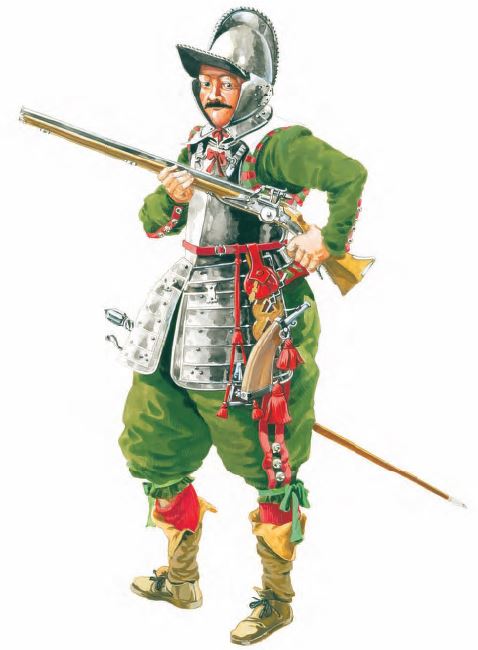
French harquebusier
French harquebusier in Canada, between 1610 and 1620. (Reconstitution by Michel Pétard (Department of National Defence))
The torture was however highly ritualized and apparently its purpose was to calm the souls of people who had died violently. The prisoner was usually tied to a post and his fingernails were pulled out and various parts of his body were burned, often with a brand or red-hot metal tools. The idea was to prolong the agony for as long as possible so the captive could prove his courage and endurance. The torment usually ended at the stake, where the prisoner was finally immolated. In some cases, the victors ate the heart or part of the body of a prisoner they considered particularly courageous. The Jesuit Jean de Brébeuf, who lived among the Huron in the 1630s, explained the ritualised cannibalism in these terms: ‘if [the prisoner] was valiant, they tore out his heart, grilled it on coals and distributed pieces to the youths; they believe it gives them courage.’
Not all captives were tortured and put to death. Women and young boys were generally spared and given to bereaved families to replace the deceased. When a prisoner was adopted in this manner, he or she took on the name, character, role and responsibilities of the person he or she was replacing and was treated with great affection. If he had been tortured, he was cared for and healed. Pierre-Esprit Radisson, a young French adventurer who was captured and tortured by the Iroquois in the 1650s, reported: ‘My [adoptive] mother treated my wounds and injuries … and in less than 15 days the wounds had healed.’ War, therefore, occupied an important place in Aboriginal societies. Consequently, their relations with the Europeans were frequently of a military nature, either as allies or as enemies.
